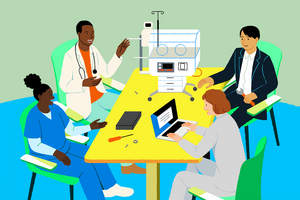Podcast transcript
[music prelude]
Fred SCHMALZ: So you have an idea. A big idea. An ambitious idea. You want to bring to market a product that will shake up an industry. But the path isn’t going to be easy, and it isn’t going to be cheap. So how are you going to get from here to there when there is really far away?
Hello, and welcome to Insight In Person, a monthly podcast produced by the Kellogg School of Management at Northwestern University. I’m your host, Fred Schmalz.
This month, we learn about two entrepreneurs with big plans. One wants to create 3D sensors that can be integrated into self-driving cars; the other is building a life-saving medical device for use in remote regions in Africa.
We hear why accomplishing these goals may require moving the finish line, drawing several finish lines, or running a different race altogether. So stay with us.
[music interlude]
SCHMALZ: Entrepreneur Jesse Chang’s startup, MDAR Technologies, is developing 3D scanning technology for robotic-vision systems. While their technology is currently being tested—they’re working out the kinks—it has the distinct advantage of functioning well in a variety of weather conditions. Chang hopes these features will make MDAR’s scanners a good fit for many industries, including driverless cars.
Jesse CHANG: As you can imagine, when you’re in a self-driving car, you want to be able to see not only in 2D but also in 3D, and if your self-driving car can’t see in 3D in conditions like snow, fog, and rain, as you might imagine, that would be a significant challenge.
SCHMALZ: But there are a few reasons why we won’t be seeing any of Chang’s products in driverless cars anytime soon.
CHANG: Selling into automotive is obviously a very long and drawn-out process, and on top of that the market is not here today yet.
SCHMALZ: Big automotive companies don’t generally flock to every relatively untested startup that approaches them. And how many driverless cars do you see on the road today? How long will it take before driverless cars are affordable to a broad swath of the population? MDAR Technologies knows that years of development and testing lie ahead in the automotive industry. So what is a startup supposed to do in the meantime?
Here’s David Schonthal, a clinical assistant professor of innovation and entrepreneurship at the Kellogg School.
David SCHONTHAL: I think a lot of entrepreneurs are thinking about the very sexy, long-term strategy about when they’re in the car, or when they’re in the airplane, or whatever the ultimate outcome for the technology might be. To put yourself in a radio-controlled car or a quadcopter drone may not be as exciting to you as the founding visionary as the long-term goal.
SCHMALZ: Devoting your startup’s resources to intermediate steps may feel underwhelming compared to an actual self-driving car. But Schonthal points out that milestones like these can be critical. They allow you to prove whether the product is viable, whether people want it, and how feasible it is. These milestones also give you a chance to generate some revenue. They can also safeguard against the risks of having all your eggs in one basket.
SCHONTHAL: If you’re only going for the thing that’s going to take you $100 million and 15 years or 10 years to get there, and you fail along that journey, only aiming at that goal, those mistakes are company-killing mistakes. Versus, if you plan a road map that has closer-end objectives where the cost of failure is a hiccup or an opportunity to adapt, but not necessarily one that you’ve got a ton of sunk cost in and makes you reboot the entire thing—that offers degrees of freedom that can be helpful in the long run.
SCHMALZ: So how is Chang’s company adapting to the reality that driverless cars are still years away? Their current strategy is to pursue other markets, existing markets. Essentially, they are creating finish lines they can cross right now. The first step? Chang and his team are making inroads in the hacker/maker market as they are prototyping their technology.
CHANG: That’s just people working on things like drones out of their house. Interesting fact: there are more private drone operators than there are government/military drone operators.
SCHMALZ: It’s not a huge market—Chang estimates it at about a billion dollars, a tiny fraction of the eventual market for driverless cars. But this particular market has some pretty hefty advantages. Hackers and makers are tinkerers, DIY-ers, MacGyvers. They are well equipped to give a product the ultimate test-drive.
CHANG: These hackers and makers are more on the innovative side of the adoption curve. While our technology is still in its nascent stage and we’re still developing it and working out the kinks, it’s very important for us to get data on how it works in the real world, and it’s also important for us to work with people that are innovators, people that can help us figure out, what are those cool new applications that we haven’t thought of yet?
SCHMALZ: Chang and his team have also been reaching out to research labs—places where robotic innovation is accelerating at an enormous pace. The hope is that these “institutional hacker/makers” will develop and test its products for more rigorous applications—like cars. And there are other interim markets on the horizon. Like the industrial automation market, which is interested in using the sensors to improve efficiency in their factories. That market already exists. And it is much bigger than the hacker/maker market: about $6 billion, Chang estimates. The company has chosen these markets carefully, gauging current and potential market size, customers’ willingness to pay, and access to other markets.
Here’s Chang again.
CHANG: We’ll have the resources and capability and testing needed to create a very well-defined product that works very well for self-driving cars and price point much lower.
SCHMALZ: Finally, MDAR is lining up what’s known as “channel partnerships.” Essentially, they want to develop working relationships with other companies that might one day incorporate MDAR’s technology into their own products. For businesses that require heavy capital investments for R&D, these channel partnerships can make or break them. But startups often view them as inevitable outgrowths of their great business ideas, rather than hypotheses that need to be tested. And this misunderstanding can lead to trouble.
Here’s David Schonthal again.
SCHONTHAL: There’s typically a development or commercial partnership assumption that people make—“If this is awesome, then clearly GE will be a partner with us and help us distribute it”—and if your entire business model hangs on a GE or a Johnson & Johnson or a BASF to get to market, it would probably be a good idea to go to test that one early before you get down the path and realize only later in the game that maybe they’re not that interested.
SCHMALZ: The variety of development strategies MDAR Technologies has lined up—from research relationships to channel partnerships—give it a range of finish lines, some incremental, some entirely new.
CHANG: I think that a good entrepreneur will be able to sit down and think about their technology and think about, what are the problems that we’re trying to solve? That leads to what markets you’re trying to enter. I would say that self-driving cars are another step in part of our broader vision to help robotic vision become better overall for all sorts of robotic applications.
SCHMALZ: This open mind may serve MDAR Technologies well if it takes longer to break into these interim markets than expected, or if a decade from now driverless cars are still a pipedream. Here’s Schonthal again.
SCHONTHAL: The entrepreneurs that get themselves into trouble are the ones that say so certainly we are going to this many degrees north and this many degrees west and then find along the way that that’s just not what the market has in mind for them and have to go back. It’s as much about a practical adjustment as it is about an emotional adjustment, which is really difficult.
[music interlude]
SCHMALZ: In 2006, the Kellogg Global Health Initiative—a partnership among academics, the private industry, and nonprofit donors—began working on a new technology to improve diagnostic tests for communicable diseases in sub-Saharan Africa. And without digging too deeply into the science, the group had two general options. Here’s Kara Palamountain, a research assistant professor of innovation and entrepreneurship at the Kellogg School, and also the Global Health Initiative’s executive director.
Kara PALAMOUNTAIN: One would be a molecular approach for testing, and the other one would be an immunoassay approach. The real difference between those two is that in the immunoassay approach, you’re measuring a patient’s response to a particular pathogen or bug, and that most often is an antibody. And the molecular approach, you’re actually detecting the bug itself.
SCHMALZ: When the team headed into rural medical clinics to examine how testing for HIV was being conducted, they found something surprising.
PALAMOUNTAIN: So that immunoassay approach that we had was already widely deployed and at nearly every single health facility that we went into. It was very accessible. It was very cheap. It was very easy to use. Very inspiring as far as uptake and access and also a very accurate product.
SCHMALZ: There was just one problem. The immunoassay approach—which tests for antibodies—doesn’t work for one particular, and particularly fragile, group.
PALAMOUNTAIN: That was interesting just to see something that was so widely accessible and user friendly for adults but not available for babies.
SCHMALZ: That’s right: babies. Because infants carry their mother’s antibodies until they are about a year old, a diagnostic test that looks for antibodies always returns positive results when the mother is HIV positive. And that’s a problem.
PALAMOUNTAIN: These drugs are not easy to take. So putting every baby born to an HIV positive mother on therapy is expensive. Ultimately, the babies that are on therapy that are HIV negative—that’s also expensive. It’s money that could be spent putting more pregnant women on therapy to reduce that mother to child transmission.
SCHMALZ: Most often, infants in resource-constrained countries don’t receive any treatment at all until they test positive—which may be after their first birthday. And the way they are tested has huge shortcomings: blood samples are collected and sent to centralized laboratories in larger cities. But processing, transporting, and testing the samples requires expertise and refrigeration—and results can take months to deliver. Those are critical months for HIV-infected children’s chances of survival.
In fact, Palamountain and her team found that more than half of test results were not being communicated back to the babies’ parents at all.
The team had identified a clear problem—testing for infant HIV. It also knew that only a molecular approach would suffice for that population. You might think that this would make the team’s finish line relatively clear: Develop a device. Test it. Get it approved. Then distribute it to clinics.
But it turns out that the finish line wasn’t that clear. Not at all. In fact, things were only starting to get complicated.
[music interlude]
PALAMOUNTAIN: I think one of the fundamental challenges is, should you just design this for the infant test population or should you make it a platform?
SCHMALZ: That is, should the team stay the course and devote their energies to the single-minded pursuit of an HIV test for infants? Or should they think a bit bigger and design a platform that can handle multiple diagnostic tests? It’s fairly easy to see the downside of the platform approach.
PALAMOUNTAIN: Sometimes designing a platform can be overwhelming and overwhelmingly ambitious. If you want to design something that can detect 17 different tests and not just the infant test, what you end up with is some inherent trade-offs there. So you might actually make the test more complicated from a sample preparation standpoint to accommodate all the different types of samples that would go into a platform.
SCHMALZ: In other words, if you’re building a Swiss Army Knife for diagnostic testing, each individual test may end up clunkier or less effective than if the device had a single use.
Plus once you bring one product to market, you’ve shown you can do it. You can piggyback on that knowledge—and the cash flow—to bring other tests to market. So while a strategy of creating multiple finish lines may seem like more effort, it can be a way to build momentum.
But it can be tough to convince the NGOs that purchase testing devices for clinics to invest in a test that can only be used on a small subset of the population.
PALAMOUNTAIN: If you don’t have HIV and TB on any platform, you’re just a niche product, which is what the infant test is. If you don’t have those two basics, you might as well go home.
SCHMALZ: Developing a larger platform, say, one that also diagnoses HIV and Tuberculosis in adults, may improve the odds that the device gets the funding to go forward. While the Global Health Initiative team is focused on the testing device, it is working with partners who are developing a platform approach. So the product-versus-platform decision is not necessarily an either–or.
What’s more, Palamountain and her team still haven’t given up on pursuing the other HIV diagnostic techniques that use the same instrumentation as the infant HIV test to look for other diseases, like Hepatitis C.
PALAMOUNTAIN: Similar to the infant HIV test that we developed, there’s very little testing going on on an individual clinic basis for Hepatitis C. So, the other similarity between the infant HIV test that we’ve developed and the Hepatitis C test is that we’re detecting antigen. A lot of the system has already been designed to detect antigen, and we’re just customizing that platform so that it can also do Hepatitis C.
SCHMALZ: Right now, Palamountain’s team is pursuing multiple finish lines and multiple paths: a highly portable infant testing device, the less-portable platform, and the technologies within those approaches—such as the chemical testing strips—which may inspire other clinical applications.
PALAMOUNTAIN: I always have a plan B, C, D, E, and F—all the way to zed. I’m constantly shifting what’s plan B and what’s plan zed, or even plan A. The trick is not getting distracted by the second approach to achieve the first option. If you can do both and not get too distracted and achieve both, then more power to you, because you’re only improving access to technology in developing countries by not only applying it for the infant population, but to others.
[music interlude]
SCHMALZ: This program was produced by Jessica Love, Fred Schmalz, Emily Stone, and Michael Spikes.
Special thanks to Kellogg School professors Kara Palamountain and David Schonthal, and Zell Fellow and JDMBA candidate Jesse Chang.
You can stream or download our monthly podcast from iTunes, or from our website, where you can read more about entrepreneurship and innovation. Visit us at insight.kellogg.northwestern.edu. We’ll be back next month with another Insight In Person podcast.




